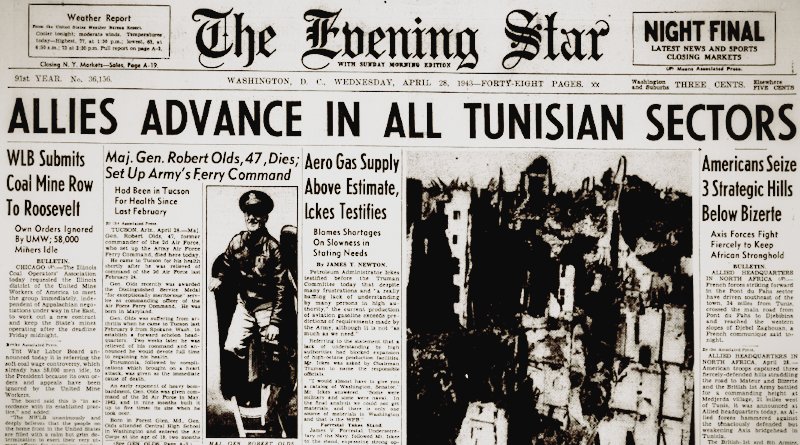World War II Chronicle: April 28, 1943
Click here for TODAY’S NEWSPAPER
Maj. Gen. Robert Olds, whom we have written about extensively in the Chronicle, has suddenly passed away (story on front page). Olds was the chief of the Army Air Force’s Ferry Command and a member of the “Bomber Mafia.” Plus he is the father of one of the most legendary fighter pilots in Air Force history — Col. Robin Olds…
George Fielding Eliot column on page 10… Sports begins on page 16… Chapter 17 of “Torpedo 8” continues on page 27.
Roving Reporter by Ernie Pyle
NORTHERN TUNISIA — Thousands are the soldiers who want someday to bring their wives and children back to Tunisia, in times of peace, and take them over the battlefields we have come to know so well. But except for the cities they will not find much to remind them of the ferocity that existed here.
I have recently traveled over the Tunisian battle area — both the part we knew so intimately because it was on our side and the part we didn’t know at all because the Germans lived there at the time.
You don’t see the desolated countryside we remember from pictures of France in the last war. That is because the fighting has been mobile, because neither side used permanent huge guns, and because the country is mostly treeless and empty. But there are some marks left.
East of El Guettar down a broad valley through which runs a nice macadam road, you see dark objects sitting far off on the plain. These are burned-out tanks of both sides.
A certain two sit close together like twins, about a mile off the road. The immense caterpillar track is off one of them and lies trailed out behind for fifty feet. The insides are a shambles. Seared and jumbled personal debris is scattered around outside. Our soldiers have already retrieved everything worthwhile from the German debris, but you can still find big wrenches, oil-soaked gloves, and twisted shell cases.
And in the side of one tank, not five feet from the great metal skeleton, is the fresh grave of a German tanker, marked by a rough wooden cross without a name.
There are many of these tanks scattered miles apart through the valley.
On the hillsides you can still see white splotches — powder marks from our exploding artillery shells, gnarled lengths of Signal Corps telephone wire, too mauled to retrieve, string for yards along the roadsides.
There are frequent filled-in holes in the macadam where artillery and dive bombers took their toll. Now and then a little graveyard with wooden crosses stands lonesomely at the roadside. Some of the telephone poles have been chopped down. There are clumps of empty ammunition boxes.
But for all these things you must look closely. There was once a holocaust here but it left only a slight permanent mark. It is sort of hard to disfigure acres of marigolds and billions of blades of fresh desert grass.
Sidi bou Zid is the little white village I saw destroyed by shellfire back in February. It was weeks later before I could get close enough to see the details, for the village remained German territory some time.
This was one of the little towns I knew so well, and now it is pitiful to look at. The village almost doesn’t exist any more. Dozens of low stone adobe buildings, stuccoed a snowy white, are nothing now but rockpiles. This village has died. The reason for the destruction of Sidi bou Zid was that German and American tank columns, advancing toward each other, met there. Artillery from both sides poured its long-distance fury into the town for hours. There will have to be a new Sidi bou Zid.
Faid Pass is the last pass in the Grand Dorsal before the drive eastward onto the long flat plain that leads to the Mediterranean at Sfax. For months we looked with longing eyes at Faid. A number of times we tried to take it and failed. But when the Germans’ big retreat came they left it so thoroughly and maliciously mined that even today you don’t dare drive off the shoulder of the road, or you may get blown to Kingdom come.
Our engineers go through these mine fields with electrical instruments, locate the mines, and surround them with warning notices until they can be later dug up or exploded. These notices are of two types — either a white ribbon strung around the mine area on knee-high sticks, or else stakes with oppositely pointing arrows on top. The white arrow pointing to the left meaning this side is safe, the red arrow pointing to the right meaning that side is mined.
And believe me, after seeing a few mine-wrecked trucks and jeeps you fear mines so dreadfully that you find yourself actually leaning away from the side of the road where the signs are, as you drive past.
Evening star. (Washington, D.C.), 28 April 1943. Chronicling America: Historic American Newspapers. Lib. of Congress.
https://chroniclingamerica.loc.gov/lccn/sn83045462/1943-04-28/ed-1/
